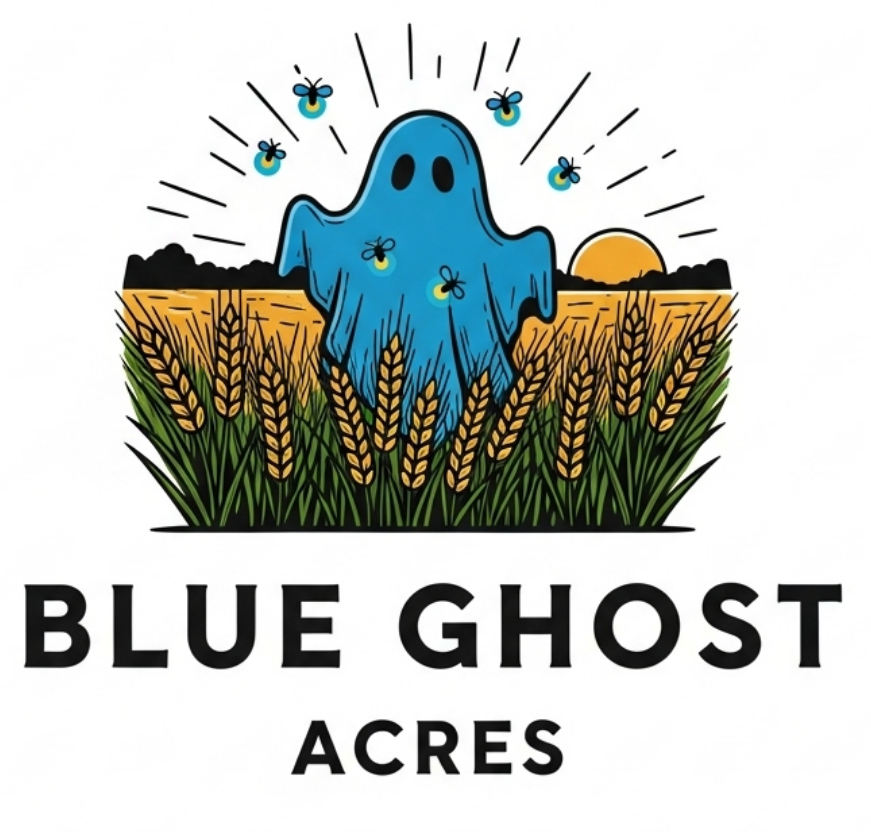From Seed to Sponge: The Complete Guide to Growing and Curing Luffa
One of the most surprising facts we love to share is that the natural luffa sponges we sell don't come from the ocean. They grow on a vine, right in our garden. Growing luffa (also spelled loofah) is one of the most rewarding projects we undertake at Blue Ghost Acres, transforming a simple seed into a useful, luxurious, and completely natural product for your home.
Think you need a tropical climate to grow your own? You might be surprised. With a little planning, you can cultivate these incredible gourds in many different regions. This is our complete guide to take you from seed to your very own homegrown sponge.
What You'll Need (The Basics)
Luffa Seeds: Look for Luffa aegyptiaca or Luffa cylindrica.
Seed Starting Pots: Peat pots or other biodegradable pots work great.
Rich Soil: Luffas are heavy feeders and love compost-rich soil.
A Sunny Spot: Find the sunniest part of your garden. Luffas need at least 6-8 hours of direct sun.
A Very Sturdy Trellis: We can't emphasize "sturdy" enough. A simple tomato cage won't cut it!
Step 1: Starting from Seed
Luffa vines have a long growing season (150-200 warm days), so for most of us, starting them indoors is essential.
When to Start: Plan to start your seeds indoors about 6-8 weeks before your last expected frost date.
Boost Germination: The tough seed coat can make germination tricky. We recommend soaking your seeds in warm water for 24 hours before planting. Some gardeners also gently nick the edge of the seed coat with a nail file.
Planting: Plant seeds about half an inch deep in your starting pots. Keep the soil consistently moist and warm—a heat mat can significantly speed up germination.
Step 2: Planting and Trellising
Once the danger of frost has passed and your seedlings are well-established, it’s time to move them to the garden.
Transplanting: Gently transplant your seedlings into rich, well-drained soil. If you used peat pots, you can plant the whole thing.
The Trellis: Luffa vines are relentless climbers and the gourds get surprisingly heavy. You need a strong, dedicated trellis, arch, or sturdy fence for them to climb. A robust cattle panel arch is one of our favorite methods. Give them plenty of room to roam!
Step 3: Growing and Care
Watering: Provide consistent moisture, especially during dry spells. Water deeply at the base of the plant.
Pollination: You’ll soon see bright yellow flowers—both male and female. Bees love them and will typically handle pollination for you. The female flowers have a tiny baby luffa at their base, while male flowers grow on a long stem.
Patience: The vines will grow vigorously all summer, but you may not see the gourds start to form until later in the season. Don't panic; this is normal!
Step 4: The Harvest
This is the most critical stage. The timing of your harvest determines what you get.
For Eating: Young, tender luffa gourds (under 6-7 inches) can be harvested while they are still deep green and cooked like zucchini or summer squash.
For Sponges (Our Goal): This requires patience. You must leave the gourds on the vine to fully mature. The signs of a ready-to-peel luffa are unmistakable:
The skin will turn from green to a yellowish-brown or deep brown.
The gourd will feel very lightweight for its size.
The skin will feel dry and brittle, starting to separate from the inner fibers.
You can often hear the seeds rattling inside when you shake it.
Step 5: Curing Your Sponge
Once you've harvested your mature, brown gourds, it's time for the magic.
Crack and Peel: The dry skin should be brittle. Smack the gourd on a hard surface to crack it, and the skin should begin to peel off easily, much like an eggshell.
Shake Out the Seeds: Once peeled, shake the gourd vigorously to get all the seeds out. Don't forget to save the biggest, healthiest seeds for next year's crop!
Rinse Thoroughly: Use a garden hose or faucet to rinse the inside and outside of the fibrous skeleton. This will wash away any remaining sap and debris.
Dry Completely: Let your new sponge dry completely in the sun. A breezy, sunny spot is perfect. The sun will also naturally lighten its color. Once it's completely dry and stiff, it’s ready to use!
A Rewarding Project
The journey from a tiny seed to a useful, beautiful sponge is one of the most satisfying on the farm. If you’re not ready to grow your own just yet, you can experience the final product by checking out our hand-cured luffas in the Blue Ghost Acres shop.

